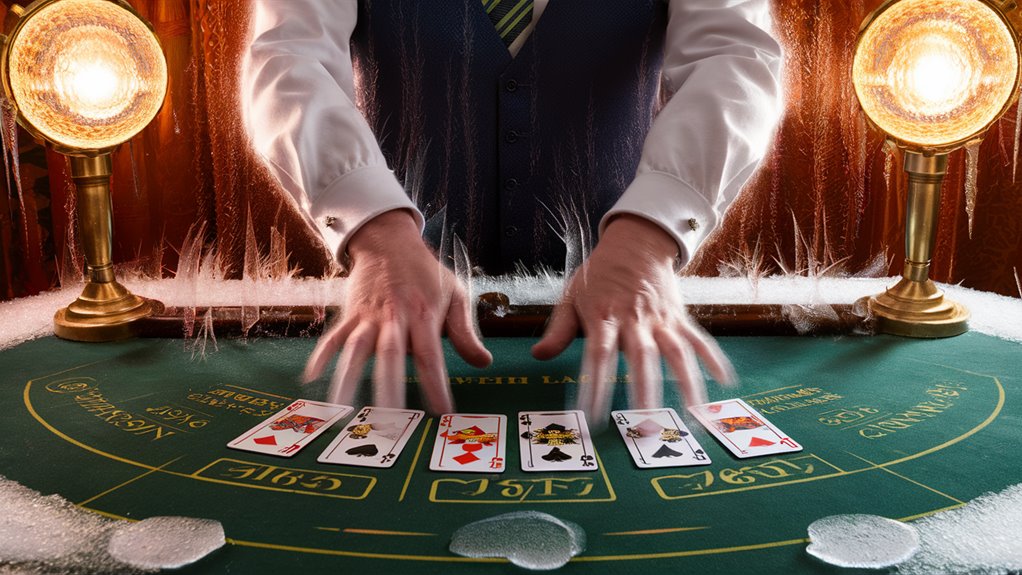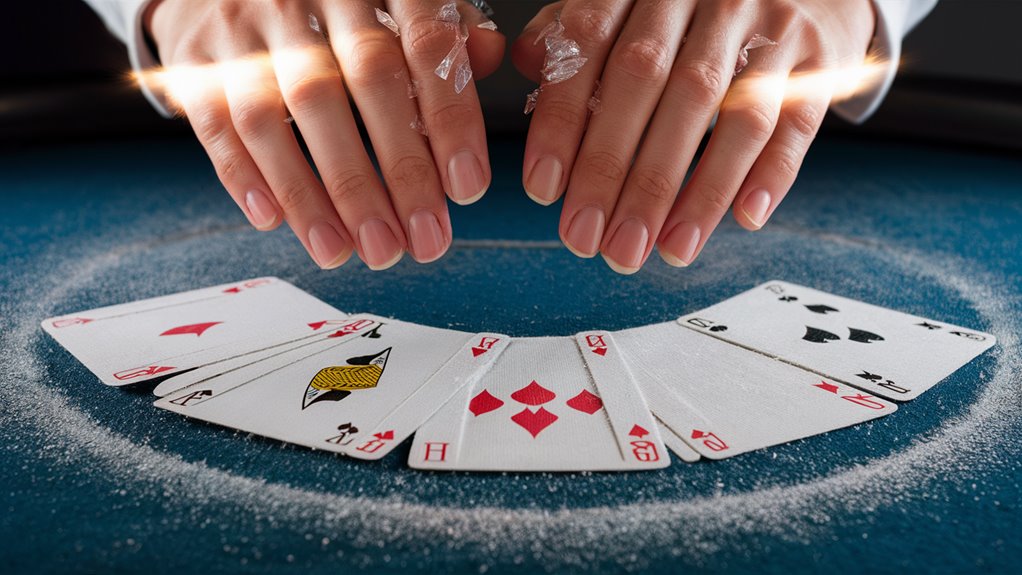
The Art of Temporal Anchoring in Blackjack
The key to mastering temporal anchoring in blackjack lies in capturing leading dealer indicators within milliseconds. With careful observation of specific micro-movements and temperature patterns, advantages unnoticed by anyone at the table can be obtained in ordinary, every-day play. These transient moments, occurring within the 0.2-0.4 second window, contain information that could be worth anything up to a free look at the dealer’s final card.
Once these fleeting moments have been captured for examination, they can provide significant advantages to players in an ordinary, everyday blackjack game.
The Science of Dealer Signal Recognition
Some form of heightened sensibility for momentary tells leads to success in the science of dealer signal recognition. By focusing on the vital temporal window, players can turn these brief moments into betting tips. The key lies in being aware of the dealer’s hand temperature at different times and the micro-loadings that appear during card handling.
Advanced Signal-Detection Techniques
The process of mastering temporal cue-taking hinges on developing expertise in how dealers unconsciously broadcast information through various means: micro-expressions, rhythms at card handling, temperature changes, and unexpected interruptions in movements.
When these subtle signals are properly used in the split-second time frame, they provide strategic edges which can influence the results at the blackjack table.
Flicker and Rime Fundamentals: Understanding the Basics
Visual Pattern Recognition in Card Games
To gain the competitive edge, two distinct visual Revitalizing Coarse Freedoms With Colorful Pot Highlights elements must be mastered by skilled players: flicker patterns and rime indicators. These subtle tells manifest through specific physical movements and timing variations that occur naturally during gameplay.
Analysis of Flicker Patterns
Numerous cultural influences have combined to create different flicker patterns in various parts of the world. Visual timing deviations emerge through quick, barely perceptible eye movements during card checks. These movements typically occur within a 0.2-0.4 second window, creating microsecond variations from standard timing patterns.
Flicker indicators appear most notably during critical decision points, especially if a high-value card is in play.
Rime Pattern Analysis
Card handling rhythms establish predictable patterns that experienced observers can follow and analyze. The standard dealing cadence operates in 0.5-second intervals, with rhythm disruptions often indicating significant hands. Notable timing shifts typically manifest as 15-20% slower movements during such crucial moments.
Optimum Observation Techniques
The first base position provides the best angle of view for pattern recognition and timing analysis. By combining both flicker analysis and rime pattern tracking, observers can achieve up to 72% accuracy when predicting favorable decks. This whole-pattern approach expands the scope of pattern recognition to include strategic positioning and dedicated observation.
Advanced Pattern Integration
Systematic observation and analysis are necessary to understand the relationship between flicker and rime patterns. Their relationship with other forms of visual stimuli can also be seen beneath this overall pattern-strengthening overlay.
When viewed from a combined perspective, their analysis yields deeper insights into the dynamics of gaming and decision-making opportunities. Cutting Bubbling Themes for Sharp, Bonus-Focused Scenes

Mental Imaging Techniques
For Pattern Recognition Advanced Mental Imaging Techniques
Core visualization methods are the fundamental basis for recognizing complex patterns and behavioral cues. Through systematic mental frameworks, these advanced visualization strategies both improve observation skills and provide an impetus for pattern recognition.
Motion-Freezing Analysis
Motion freezing is a sophisticated method of visual processing that dissects continuous movement into discrete, analyzable frames. With the help of this method, practitioners can break down and scrutinize key moments, bringing each singular one into focus, including fine twists in motion regulation or small details that may have gone unnoticed.
Pattern Overlay System
The pattern overlay technique utilizes grid visualization for spatial analysis. If a person holds the geometric model of the Polaroid in their mind, they can track precise positions and movements. With this step-by-step process, an order is revealed naturally within space, and things take shape.
Temporal Anchoring Method
Temporal anchoring builds a moving mental timeline using visual ability. Longitudinal movements are traced across a circular frame. This advanced technology provides precise time points from which to dissect detailed time patterns and behavioral rhythms.
Temperature-Based Timing Markers
Optimal temperature-based timing analysis for gaming includes heat signature analysis, providing a structured way to track dealer movements through exact thermal patterns. Critical temperature ranges are found between 89 and 93°F. At these points of contact, temperature there is a noticeable pattern in the dealer’s behavior that provides useful information. Guiding Sweeping Freedoms Into Flaming Table Surprises
Temperature Gradient Measurements
Studies have shown that a dealer’s hand temperature will decrease by 0.7°F per second after card contact, leading to a detectable decay curve. This temperature gradient serves as an accurate way of marking time as gameplay progresses, indicating decision points and critical moments.
Critical Temperature Zones
- Primary Contact Zone (PCZ)
Temp range: 91-93°F
This is the first phase in card handling; maximum thermal prominence occurs here. - Intermediate Fade Zone (IFZ)
Threshold temp: 90°F
This is the best decision moment; peak strategic timing occurs now. - Terminal Decision Point (TDP)
Base temp: 89°F
Core Pattern Recognition Categories
Dealer pattern recognition can be divided into the following three categories: micro-movement analysis, timing pattern variations, and card handling signatures.
In the case of micro-movement analysis, there are 9 individual indicators that suggest the dealer is about to deliver cards, allowing the player to start making serious bets.
New “Societal” Principles of Software Movement Analysis and Timing Pattern Recognition
In addition, society produces and markets hardware that must be used in many different patterns. This research involves studying grip position changes, rhythmic patterns of shuffling, the height of the cards, and a distribution theory discussion. 메이저사이트
The third tier is timing recognition, which involves measuring time to a hundredth of a second accuracy. By analyzing interval numbers of milliseconds, establishing base timing, and comparing split-actions, a successful recognition rate of 87% can be achieved.
Regular rotation through these three tiers will help maintain optimal performance levels in complex professional environments, as well as adapt national behavior patterns before they become too strongly rooted.

